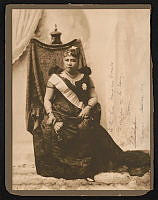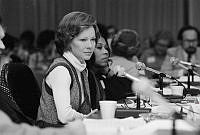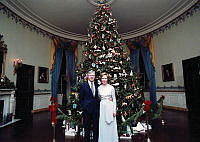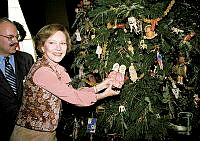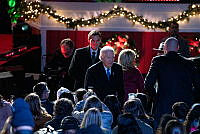Rubenstein Center Scholarship
Betty Ford: Activist First Lady
I do not believe that being first lady should prevent me from expressing my views. I spoke out on this important issue, because of my deep personal convictions. Why should my husband's job or yours prevent us from being ourselves? Being ladylike does not require silence.
Betty Bloomer Ford was not a politician. She was a dancer, a model, a wife, and a mother. She never expected to be in the political limelight—in fact, after divorcing her first husband she began dating Gerald Ford, who kept his intentions of running for Congress a secret.1 Moreover, Betty Ford certainly never anticipated becoming First Lady of the United States. Gerald Ford’s long tenure in the House of Representatives, underscored by his position as Minority Leader, was the height of her exposure to the public—or so she thought. It was not until Vice President Spiro Agnew resigned in 1973 that Gerald Ford was thrust into the spotlight as President Richard Nixon’s new Vice President. On August 9, 1974, Nixon also resigned, and Betty Ford became the first lady. Mrs. Ford then transformed into an icon in her own right—separate from the celebrity of her presidential husband.
Immediately after moving in, Betty Ford situated herself as a unique White House occupant. Betty was outspoken and unafraid to be herself, declaring “Okay, I’ll move to the White House, do the best I can, and if they don’t like it, they can kick me out, but they can’t make me somebody I’m not."2 Even more unusual than her self-proclaimed independence, Betty Ford often disagreed with her husband’s political positions, despite being a Republican herself. Within a few weeks of Ford’s swearing-in ceremony in the East Room, the first lady hosted her own press conference in the White House State Dining Room on September 4, 1974. During the press conference, she spoke about her support of the Equal Rights Amendment and her goals as first lady: “I would like to be remembered in a very kind way; also as a constructive wife of a President."3Thus began her journey as an active and outspoken first lady.

Betty Ford lobbying for the Equal Rights Amendment from her personal desk in the White House
Gerald R. Ford Presidential LibraryBetty’s activism was often intentional, but one of her most meaningful experiences came from an unwelcome and unexpected discovery just after moving into the White House: a lump in her breast. Betty underwent a radical mastectomy at Bethesda Naval Hospital and inadvertently destigmatized breast cancer by addressing her illness publicly during a White House press conference.4 Mrs. Ford later reasoned, “I thought that there are women all over the country like me. And if I don't make this public, then their lives will be gone… they're in jeopardy."5 Until the first lady addressed her illness, many Americans did not speak openly about breast cancer— it was seen as too personal and inappropriate. Betty Ford changed that. Well-wishes and get-well-soon cards flooded the White House, but more importantly, women visited doctor’s offices around the country, inspired by the first lady to get their own breast exams. Breast cancer diagnoses increased 15% following Betty’s surgery, allowing for earlier detection—potentially saving thousands of women’s lives.6
Betty Ford was also an outspoken advocate for the passage of the Equal Rights Amendment throughout her time in the White House, which demands legal equality for American citizens, regardless of gender. The ERA remains unpassed today. The 1970s saw the rise of the women’s liberation movement and the paradigm of the “liberated woman”—a traditionally domestic woman-turned-political activist. Betty fit the description perfectly, garnering nationwide support for her platforms by women’s equality activists. Although the Republican Party placed more emphasis on traditional family structure, President Gerald Ford had voted in favor of ratifying the ERA as a congressman for Michigan and he continued to support his wife in her endeavors once they were in the White House—gender equality was part of the Ford family platform.

Betty Ford speaks to a crowd about the importance of early detection of breast cancer
Gerald R. Ford Presidential LibraryTo rally support for the ERA, Betty called senators, traveled across the country to lobby for ratification, and participated in women’s conferences and meetings throughout her tenure as first lady. She even held informational sessions about the ERA in the White House family theater for the White House staff.7 In keeping with her traditional Republican views, Betty Ford made it clear that she did not believe women had to abandon the home in order to be equal to men—she cited her own experience as a mother to four children and applauded mothers who made the same choices. Betty did not look down upon homemakers—she wanted them to have as much opportunity as career women and career men to follow their passions.
Meanwhile, Betty Ford continued to utilize her access to the president to her advantage. During President Ford’s tenure, she persuaded him to appoint more women to the administration that any previous president, including Secretary of Housing and Urban Development Carla Hills. Betty also (unsuccessfully) tried to convince her husband to appoint a woman to the United States Supreme Court.8 Finally, with Betty’s encouragement, President Ford created the National Commission on the Observance of International Women’s Year by Executive Order in 1975.

The first lady praises her husband for the Executive Order issued creating the National Commission on the Observance of International Women's Year.
Gerald R. Ford Presidential LibraryThe first lady’s support of women’s liberation received mixed responses, as the movement was not universally popular, especially within her own political party. Women who saw Betty’s support for the ERA as detrimental to family values often picketed outside of the White House.9 Immediately after speaking out in support of the amendment, she received extremely critical messages in the mail, but as time went on, Betty’s views, as well as her candor, became more popular. In a six-day span in February 1975, Mrs. Ford received 5,195 pro-ERA letters in the mail, and 1,161 anti-ERA letters, suggesting that she had influenced many women to support the amendment.10 Others were inspired by her work, including Betty Friedan, author of The Feminine Mystique and a leader in the women’s liberation movement. Friedan wrote to the first lady in August 1975: “Courage and fortitude! You come across as the very best kind of liberated woman. Your sensitivity and strength is going to be a wonderful boost for millions of mothers and daughters and American women generally.”11
Betty Ford’s opinions on taboo political matters were somewhat controversial. In a 1975 60 Minutes interview in the White House Solarium, the first lady commented to a reporter that Roe v. Wade was a “great, great decision” and that she would not be surprised or angry if their teenage daughter, Susan, had an affair or tried marijuana.12 Her stance on abortion diverged from the platforms of her husband and their party. Few first ladies have so publicly stated their opinions—and even more rarely, those that deviate from the president’s. Though many took issue with her liberal, outspoken ideas, Betty skyrocketed in popularity after the interview—at many points, her approval rating outranked her husband’s, and reelection campaign buttons displayed mottos including “Betty’s Husband for President in’76” and “Keep Betty in the White House.”13

Betty Ford's controversial interview on 60 Minutes
Gerald R. Ford Presidential LibraryUnfortunately, Betty’s popularity was not enough to keep President Ford in the White House. Upon losing to Democratic candidate, Jimmy Carter, Betty gave her husband’s concession speech, as he had lost his voice while campaigning, and her voice was heard around the world. Her impact did not end when she and her family vacated the Executive Mansion, however; many of Betty Ford’s most important contributions to activism came after her tenure as first lady ended in 1977.
After leaving the White House, the Ford family moved to Rancho Mirage, California, and Betty Ford’s reliance on prescription medicine and alcohol, which began prior to her time in Washington, D.C., became apparent and life-threatening. Originally prescribed for a pinched nerve, Betty had become increasingly reliant on the medication, taking more than prescribed for her condition. The Ford family staged an intervention on April 1, 1978, and forced the former first lady to acknowledge the detrimental effects that her addiction had on her family relationships and her own health. On that day, Betty Ford agreed to detox from her medications and attend rehabilitation at Naval Regional Medical Center in Long Beach, California. Betty’s determination and strong family support helped her get sober, and in 1978, her first memoir, The Times of My Life, openly discussed her battle with addiction. Betty’s second book, Betty: A Glad Awakening, provided transparency and inspiration for recovering addicts across America.14
Betty Ford went beyond sharing her story. In 1982, she co-founded the Betty Ford Center, a treatment center for drug and alcohol rehabilitation in Rancho Mirage, California.15 Betty specified that the treatment center, which is now considered the premier location for rehabilitation in the country, should have gender-specific programs, after realizing through her own struggle that women often fail to seek help for addiction. After opening the Center, Betty Ford visited almost daily, meeting and encouraging patients on their road to recovery.16

Betty Ford stands outside of the Betty Ford Center, 1990
Betty Ford CenterIn the final years of her life, Betty Ford continued her involvement with causes that were most important to her: addiction treatment, breast cancer awareness, and women’s equality. In the 1980s, Mrs. Ford chose to speak out on another highly stigmatized problem—the HIV/AIDS crisis. Through her work at the Betty Ford Center, she understood the link between drug abuse and AIDS, and became involved in the Los Angeles AIDS Project. In 1985, she received the Commitment to Life Award from the L.A. AIDS Project. In her acceptance speech, she described her own battle with:
…two diseases, that for a long time nobody wanted to talk about: cancer and alcoholism. With public awareness, attitudes toward these have been changed. Attitudes can be changed about AIDS too. They are changing. In my life, being part of this is important. . . . Thank you for allowing me the opportunity to help with the understanding of another disease.17
She later wore her AIDS ribbon pin to the 1992 Republican National Convention.18 Betty continued to support gay and lesbian rights throughout her lifetime, speaking out against military discrimination and in favor of same-sex marriage.19

Betty Ford receives the Presidential Medal of Freedom from President George H. W. Bush in 1991 for her public service
George H. W. Bush LibraryFor her work, Betty Ford received some of that nation’s highest honors, including the Presidential Medal of Freedom, induction into the National Women’s Hall of Fame, and a Congressional Gold Medal.20 Betty Ford passed away on July 8, 2011, leaving $500,000 for the Betty Ford Center.21 She is perhaps best described in former First Lady Rosalynn Carter’s eulogy: Betty Ford was “someone who was willing to do things a bit differently than they had been done before…someone who had the courage and grace to fight fear, stigma, and prejudice wherever she encountered it.”22 Betty Ford’s transparency and activism saved countless American lives and inspired new generations of women to speak out about important political matters. President Ford himself admitted that “when the final tally is taken, her contributions to our country will be bigger than mine.”23





